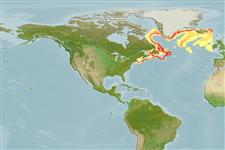Elasmobranchii (Haie und Rochen) (sharks and rays) >
Rajiformes (Skates and rays) >
Rajidae (Skates)
Etymology: Amblyraja: Greek, amblys = darkness + Latin, raja, -ae = ray (Raja sp.) (Ref. 45335).
Eponymy: Professor Adolf Severin Jensen (1866–1953) was a Danish zoologist, ichthyologist and malacologist. [...] (Ref. 128868), visit book page.
Issue
Provisionally retained as valid but treated as junior synonym of A. hyperborea by Weigmann (2016, Ref. 106604) due to strong morphological similarity and preliminary molecular data. Further work is needed to resolve this issue (Ref. 118749).
Environment: milieu / climate zone / depth range / distribution range
Ökologie
seewasser bathydemersal; tiefenbereich 165 - 3000 m (Ref. 114953). Deep-water; 67°N - 39°N, 72°W - 10°W (Ref. 114953)
Western Atlantic: Nova Scotia, Canada to southern New England, USA; Eastern Atlantic: Iceland (Ref. 12462); North Atlantic: Labrador Sea and off British Isles (Ref. 114953)
Size / Gewicht / Alter
Maturity: Lm ? range ? - ? cm
Max length : 74.3 cm TL Männchen/unbestimmt; (Ref. 4926); 85.0 cm TL (female)
Kurzbeschreibung
Bestimmungsschlüssel | Morphologie | Morphometrie
Lacks large thorns on anterior margins and mid posterior parts of pectorals and on either side of mid-dorsal ridge on the disc. Upper surface plain light brown, either grayish or of chocolate hue, darker along margins of fins. Lower surface brownish gray, grayish white or perhaps pure white (Ref. 6902).
Benthic (Ref. 58426). Deep-water species. Prefers higher temperatures. Feeds on small fishes and crustaceans (Ref. 6902). Oviparous (Ref. 50449). Eggs have horn-like projections on the shell (Ref. 205). Maximum depth reported taken from Ref. 117245. It may be captured as by-catch in deep water fisheries, but due to its depth preference, it is less likely to be vulnerable (Ref. 117245).
Life cycle and mating behavior
Geschlechtsreife | Fortpflanzung | Ablaichen | Eier | Fecundity | Larven
Oviparous, paired eggs are laid. Embryos feed solely on yolk (Ref. 50449). Eggs have horn-like projections on the shell (Ref. 205).
McEachran, J.D. and K.A. Dunn, 1998. Phylogenetic analysis of skates, a morphologically conservative clade of elasmobranchs (Chondrichthyes: Rajidae). Copeia 1998(2):271-290. (Ref. 27314)
IUCN Rote Liste Status (Ref. 130435: Version 2024-2)
Bedrohung für Menschen
Harmless
Nutzung durch Menschen
Tools
Zusatzinformationen
Download XML
Internet Quellen
Estimates based on models
Preferred temperature (Ref.
123201): 3.1 - 4, mean 3.6 °C (based on 69 cells).
Phylogenetic diversity index (Ref.
82804): PD
50 = 0.5010 [Uniqueness, from 0.5 = low to 2.0 = high].
Bayesian length-weight: a=0.00302 (0.00141 - 0.00645), b=3.24 (3.07 - 3.41), in cm total length, based on LWR estimates for this (Sub)family-body shape (Ref.
93245).
Trophic level (Ref.
69278): 3.7 ±0.57 se; based on food items.
Widerstandsfähigkeit (Ref.
120179): niedrig, Verdopplung der Population dauert 4,5 - 14 Jahre. (Fec assumed to be <100).
Fishing Vulnerability (Ref.
59153): Moderate to high vulnerability (54 of 100).
Nutrients (Ref.
124155): Calcium = 4.4 [0.7, 91.3] mg/100g; Iron = 0.345 [0.032, 4.848] mg/100g; Protein = 14.9 [12.9, 17.0] %; Omega3 = 0.479 [0.188, 1.215] g/100g; Selenium = 18.7 [3.3, 89.1] μg/100g; VitaminA = 7.03 [0.51, 95.98] μg/100g; Zinc = 0.266 [0.018, 3.130] mg/100g (wet weight);
